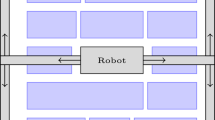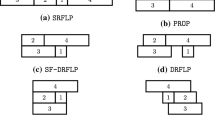Abstract
We present a two-stage method using mathematical-programming techniques for finding high-quality solutions to the multi-floor facility layout problem. The first stage is a mixed-integer linear program that assigns departments to floors such that the total of the vertical interaction costs between departments on different floors is globally minimized. The second stage finds a locally optimal layout for each floor. Two versions of the proposed approach are considered. The first solves the layout of each floor independently of the other floors, and is suitable for up to one elevator location. The second solves the layout of all floors simultaneously and can handle multiple elevator locations. Preliminary computational results show that both versions of the proposed method can efficiently provide a good variety of high-quality solutions in a short amount of time for medium and large-scale problem instances.




Similar content being viewed by others
References
Abdinnour-Helm S and Hadley SW (2000). Tabu search based heuristics for multi-floor facility layout. International Journal of Production Research 38 (2): 365–383.
Anjos MF and Vannelli A (2002). An attractor-repeller approach to floorplanning. Mathematical Methods of Operations Research 56 (1): 3–27.
Anjos MF and Vannelli A (2006). A new mathematical-programming framework for facility-layout design. INFORMS Journal on Computing 18 (1): 111–118.
Armour G and Buffa E (1963). A heuristic algorithm and simulation approach to relative location of facilities. Management Science 9 (1): 294–309.
Bozer YA, Meller RD and Erlebacher SJ (1991). An improvement-type layout algorithm for multiple-floor facilities. Technical Report 91-11, Department of Industrial & Operations Engineering, University of Michigan.
Bozer YA, Meller RD and Erlebacher SJ (1994). An improvement-type layout algorithm for single and multiple-floor facilities. Management Science 40 (7): 918–932.
Chang C-H, Lin J-L and Lin H-J (2006). Multiple-floor facility layout design with aisle construction. Industrial Engineering & Management Systems 5 (1): 1–10.
Goetschalckx M and Irohara T (2007). Efficient formulations for the multi-floor facility layout problem with elevators. Georgia Institute of Technology, http://www.optimization-online.org/DB_FILE/2007/02/1598.pdf.
Hahn P, MacGregor Smith J and Zhu Y-R (2010). The multi-story space assignment problem. Annals of Operations Research 179 (1): 77–103.
Heragu SS (2006). Facilities Design. 2nd edn. iUniverse: Lincoln, NE.
Johnson RV (1982). SPACECRAFT for multi-floor layout planning. Management Science 28 (4): 407–417.
Kaku BK, Thompson GL and Baybars I (1988). A heuristic method for the multi-story layout problem. European Journal of Operational Research 37 (3): 384–397.
Kusiak A (2000). Computational Intelligence in Design and Manufacturing. John Wiley & Sons: New York.
Lee K-Y, Roh M-I and Jeong H-S (2005). An improved genetic algorithm for multi-floor facility layout problems having inner structure walls and passages. Computers & Operations Research 32 (4): 879–899.
Liggett RS and Mitchell WJ (1981). Optimal space planning in practice. Computer-aided Design 13 (5): 277–288.
Matsuzaki K, Irohara T and Yoshimoto K (1999). Heuristic algorithm to solve the multi-floor layout problem with the consideration of elevator utilization. Computers & Industrial Engineering 36 (2): 487–502.
Meller RD and Bozer YA (1992). Solving the facility layout problem with simulated annealing. Technical Report 91-20, Department of Industrial & Operations Engineering, University of Michigan.
Meller RD and Bozer YA (1996). A new simulated annealing algorithm for the facility layout problem. International Journal of Production Research 34 (6): 1675–1692.
Meller RD and Bozer YA (1997). Alternative approaches to solve the multi-floor facility layout problem. Journal of Manufacturing Systems 16 (3): 192–203.
Meller RD and Gau K-Y (1996). The facility layout problem: recent and emerging trends and perspectives. Journal of Manufacturing Systems 15 (5): 351–366.
Singh SP and Sharma RRK (2006). A review of different approaches to the facility layout problems. International Journal of Advanced Manufacturing Technology 30 (5–6): 425–433.
Acknowledgements
We thank two anonymous referees for their constructive comments that helped improve the paper.
Author information
Authors and Affiliations
Corresponding author
Additional information
†Research partially supported by an Ontario Graduate Scholarship.
††Research partially supported by the Natural Sciences and Engineering Research Council of Canada, and by a Humboldt Research Fellowship.
Rights and permissions
About this article
Cite this article
Bernardi, S., Anjos, M. A two-stage mathematical-programming method for the multi-floor facility layout problem. J Oper Res Soc 64, 352–364 (2013). https://doi.org/10.1057/jors.2012.49
Received:
Accepted:
Published:
Issue Date:
DOI: https://doi.org/10.1057/jors.2012.49




